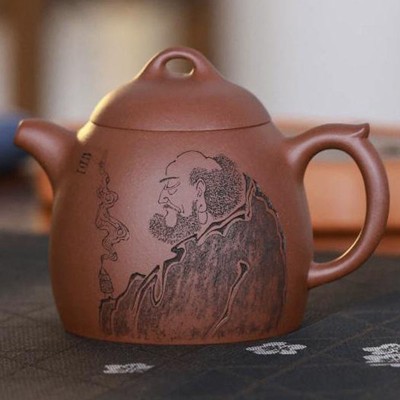




"Qinquan" yixing teapot is inspired by the standardized weights and measures of ancient China's Qin dynasty. The name "quan" refers to the weights used for measuring weight. The teapot's design is modeled after the shape of these weights. The dragon-shaped handle of the "Qinquan" teapot exudes a powerful and unyielding aura, while the pot itself embodies the same sense of dignity and strength.
 Delivery
Delivery
Free shipping within 1 to 3 days. ETA:5-7 days
 Returns
Returns
Within 28 days after delivery date.
 Security
Security
SSL | GDRP used to ensure information security.
Guarantee safe & secure checkout
Data sheet
My Yixing teapot arrived today and it's absolutely stunning! The craftsmanship is impeccable and it's a beautiful addition to my teapot collection. The whole ordering process was smooth, and I'm very happy with my purchase. Can't wait to brew some tea in it!
"Fanggu" Yixing Teapot - This zisha teapot has an antique cylindrical body shaped like a drum, with a short neck imitating the shape of a drum pot. The spout is also designed to imitate the shape of a drum pot spout, with a straight line. Its advantages include excellent heat preservation, natural color, comfortable texture, and long service life. The "Fanggu" teapot is a unique and elegant choice for tea lovers and collectors alike.
As a shape, "Ruyi" is a common pattern and object shape in traditional Chinese culture,the "Ruyi" shape represents auspicious, happiness, and good meanings in Chinese culture.
"Shipiao" Yixing teapot- this zisha teapot is a traditional Chinese tea set characterized by its gourd-like or calabash-like shape, with a small top and large bottom, a sturdy and short spout, and a pyramid-shaped body that exudes elegance. Made from high-quality purple clay material, this teapot is known for its hardness and durability, as well as its stable and easy-to-use design. The short and powerful straight spout ensures a smooth and steady flow of water, while the pyramid-shaped body adds a touch of sophistication to any tea ceremony.
"Yuhualong" is a classic yixing teapot shape, meaning "fish leaping over the dragon gate". The small fish-turned-dragon teapot knob made by Tang Shuzhi in the Republic of China is in the shape of rolling clouds, and the pot body is shallowly sculpted with waves. The dragon head protrudes from the waves, and the dragon tail curls into the handle, with clear scales carved on the handle. In the Qing Dynasty, Shao Daxiang's fish-turned-dragon was sculpted in layers of waves, with a strong three-dimensional sense, and the dragon head was short and thick, hidden in the lid without showing its claws. The knob was in the shape of stacked waves. Placing this teapot in the office or at home symbolizes good luck in all things, promotion in work, or academic advancement for students.
"Zhugu" zisha teapot,taking bamboo as its theme, this teapot exaggerates and transforms its form, with the body sculpted into a trunk and the bamboo joints simplified and elegant, exuding a sense of stability and balance. The spout and handle are crafted into new tender branches, with a dynamic and powerful momentum. The lid is topped with a sculpted, curved bamboo twig in the shape of a bridge, with bamboo leaf patterns attached beneath the knob. This work perfectly captures the unique characteristics and noble qualities of bamboo, and the Bamboo Drum teapot has a unique place among yixing teapots due to its distinctive design.
"Suyuan" refers to the simple and unadorned appearance of this type of yixing teapot, with smooth and rounded lines and no patterns or decorations. The design philosophy of the "Suyuan" purple clay teapot is to pursue a natural, simple and pure aesthetic, allowing the taste and aroma of the tea to be fully displayed, hence the name "Suyuan".
"Meirenjian" yixing teapot resembles an ancient woman, dignified and lovely, with a hint of palace elegance and grace, yet without losing the charm of a young lady. The shape is full and elegant, mainly reflecting the roundness of the pot body. The pot cover and the pot body seem to be integrated without any gaps. When touched by hand, one can feel its warmth.
"Shipiao" Yixing teapot- this zisha teapot is a traditional Chinese tea set characterized by its gourd-like or calabash-like shape, with a small top and large bottom, a sturdy and short spout, and a pyramid-shaped body that exudes elegance. Made from high-quality purple clay material, this teapot is known for its hardness and durability, as well as its stable and easy-to-use design. The short and powerful straight spout ensures a smooth and steady flow of water, while the pyramid-shaped body adds a touch of sophistication to any tea ceremony.
This is a type of teapot shape that was created during the Yuan Dynasty. It's called "SengMao" because the shape of the spout resembles a monk's hat. The shape of the teapot has a raised lip, a low front and high back, a duck-bill shaped spout, and the lid rests inside the lip. It has a narrow neck, a bulging belly, a circular foot, and a curved handle, and is characterized by a strong ethnic minority style.. Initially, it was used exclusively for Buddhist monks to drink tea, but over time it gradually became a classic shape of the square zisha teapot.
"Shipiao" Yixing teapot- this zisha teapot is a traditional Chinese tea set characterized by its gourd-like or calabash-like shape, with a small top and large bottom, a sturdy and short spout, and a pyramid-shaped body that exudes elegance. Made from high-quality purple clay material, this teapot is known for its hardness and durability, as well as its stable and easy-to-use design. The short and powerful straight spout ensures a smooth and steady flow of water, while the pyramid-shaped body adds a touch of sophistication to any tea ceremony.
The eggplant-shaped Yixing teapot is a classic example of the zisha teapot. It is characterized by its unique shape, which resembles an eggplant, and is made of purple clay, also known as zisha clay.
The Xishi yixing teapot is the quintessential model and the most popular style of Yixing clay teapot. It boasts a round and plump body, a cut lid, a short spout, and an inverted handle. The pot's body resembles the full breast of a young woman, while the knob on the lid is shaped like a nipple. The bottom of the pot curves inward naturally, and the handle is fashioned like an upside-down ear, reminiscent of the hairstyle of ancient Chinese women. When pouring tea, the handle resembles the slender waist of a beautiful woman. The Xishi teapot is renowned for its unique ability to brew tea, allowing the tea leaves to fully expand and release a more intense aroma and flavor.
NOTICE : Cookies ensure the smooth running of our services and improve user experience,Using these, you accept the use of cookies. Learn More.